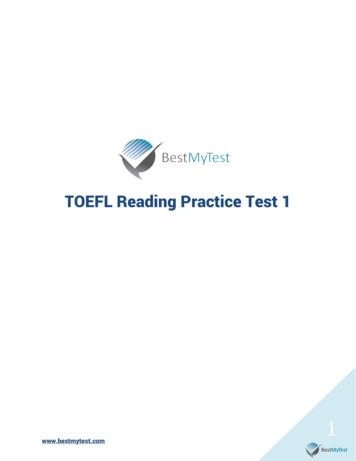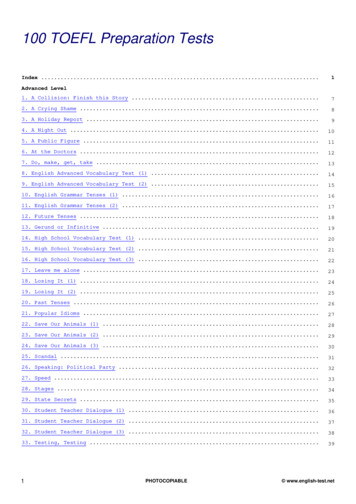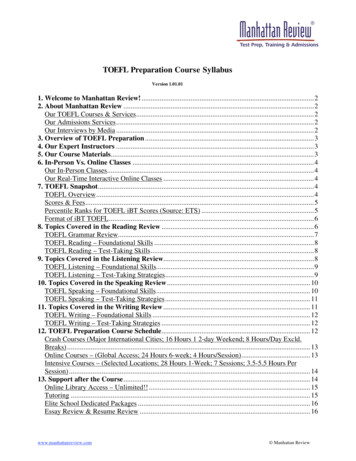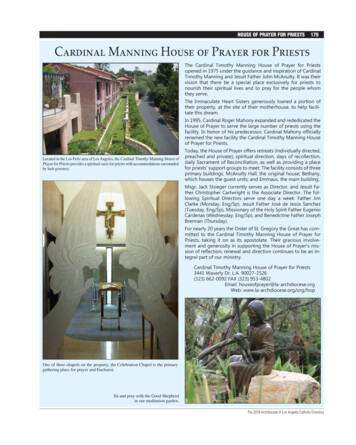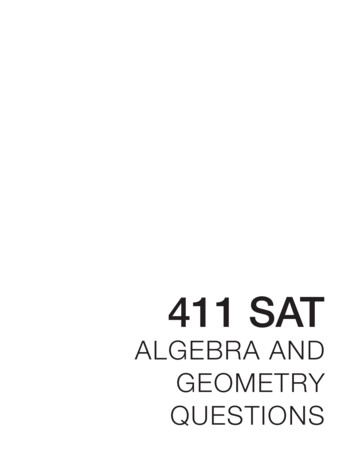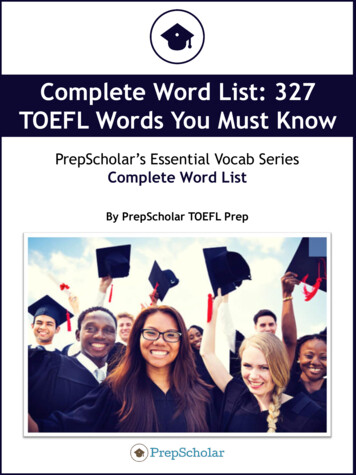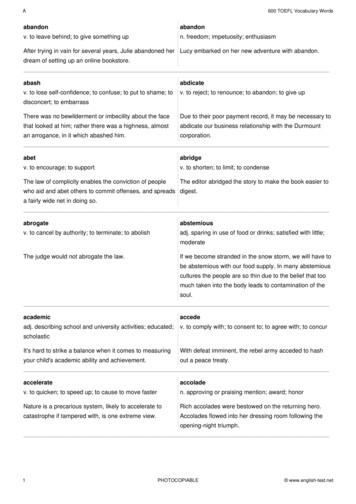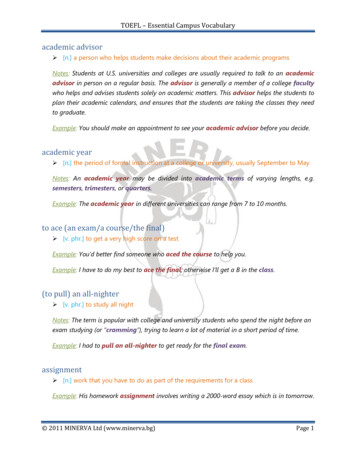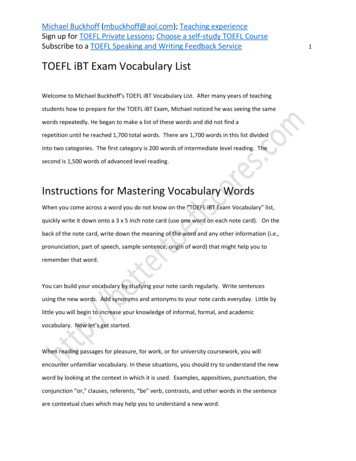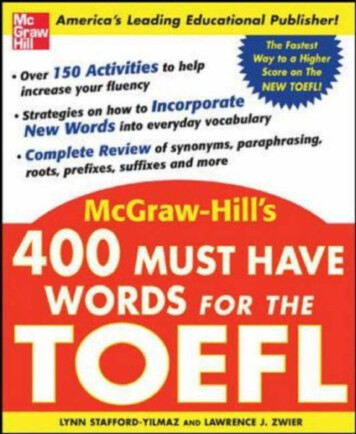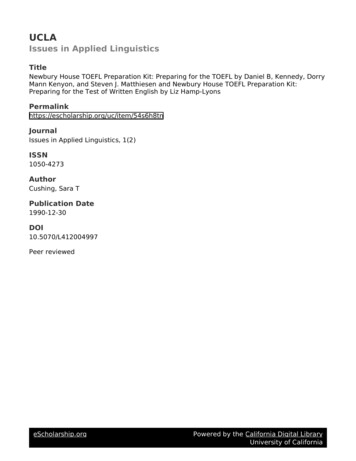
Transcription
UCLAIssues in Applied LinguisticsTitleNewbury House TOEFL Preparation Kit: Preparing for the TOEFL by Daniel B, Kennedy, DorryMann Kenyon, and Steven J. Matthiesen and Newbury House TOEFL Preparation Kit:Preparing for the Test of Written English by Liz m/54s6h8tnJournalIssues in Applied Linguistics, 1(2)ISSN1050-4273AuthorCushing, Sara TPublication Date1990-12-30DOI10.5070/L412004997Peer reviewedeScholarship.orgPowered by the California Digital LibraryUniversity of California
Issues in Applied Linguistics Vol.1 No. 21990281Newbury House TOEFL PreparationKit:Preparing forthe TOEFL by Daniel B. Kennedy, Dorry Mann Kenyon, andSteven J. Matthiesen. New York: Newbury House, 1989. 262 pp.Newbury House TOEFL PreparationPreparing forthe Test of Written English by Liz Hamp-Lyons. New York:Newbury House,1989.Kit:134 pp.Reviewed bySara T. GushingUniversity of California,Los AngelesRecent research on the Educational Testing Service's Test ofEnglish as a Foreign Language (TOEFL) suggests that, while theTOEFL is a valid test of language proficiency, it tests only a limitedrange of communication skills and ignores many skills required bystudents in American university settings (Duran et al., 1985). Thereis also no clear evidence of any relationship between high TOEFLscores and academic achievement (Graham, 1987). Such findingsraise questions about the appropriacy of using TOEFL preparationbooks in courses for university-bound ESL students, especiallygiven the current orientation in academic-purpose language teachingto promote communicative competence rather than the sort of discretelanguage knowledge which is tested in many sections of the TOEFL.Indeed, conscientious teachers may wonder whether they are doingtheir students a disservice by spending class time on exercisesspecifically designed to raise TOEFL scores, at the expense ofactivities which promote the general academic skills needed at theuniversity. At the same time, those language testing researchersconcerned with the TOEFL's limitations might ask whether TOEFLpreparation books do more harm than good since they perpetuate thestatus quo rather than encourage improvement of the TOEFL alongthe lines that some experts have suggested (Savignon, 1986; LarsenFreeman, 1986) so as to increase its ability to measurecommunicative skills.The Newbury House TOEFL Preparation Kit is by no meansradical in its attitude towards the TOEFL, but it does attempt toprovide a partial answer to the first of these dilemmas. While theauthors take a pragmatic approach toward the discrete-point sectionsof the TOEFL, they also emphasize those areas of the TOEFL which
282Reviewsneeds of university students. Themanual that provides practicalreadresult is a well-written, easy tosuggestions for doing well on the discrete-point grammar, listening,and vocabulary items of the TOEFL. Additionally, the Kit promotesthe acquisition of academic skills, especially in reading and writing,to help students deal with the TOEFL as it exists today and with theacademic requirements of the American universities they hope toaremore relevantto the futureattend.The Kit contains two volumes-Preparing fortheTOEFL(PFT) and Preparing for the Test of Written English (PTWE)-aswell as two audio cassettes which simulate the listening sections ofthe practice tests, and a separate tapescript and answer key, all neatlypackaged together in a plastic binder. PFT has many features typicalTOEFLpreparation books now on the market: answers tocommonly asked questions about the TOEFL, descriptions of thevarious parts of the test, sample exercises for each section, andHowever, a few crucial differences make thepractice tests.Newbury House Kit notable. First is the authors' attention to thestrict specifications of item types and formats which TOEFL itemwriters follow. The authors have clearly spent considerable timestudying numerous forms of the TOEFL and, in essence, haverecreated the test specifications so as to characterize the kinds ofquestions found on the TOEFL in terms of content, format, anddifficulty. The result is that they are able to give detailed informationfor each test section about the language skill being tested (e.g.,listening for specific information, making inferences), about thequestion formats, and about the strategies needed to answer a givenofquestion type.In discussing these strategies, the authors implicitlydistinguish between those sections which test discrete language itemsand those which test integrated skills. The practical and concretesuggestions for dealing with the former are meant to help studentsperform as well as possible whatever their level of languageproficiency. These hints are not unlike those found in other TOEFLMuiioz, 1986); however,Stanley, 1983; Pylebooks (e.g. Kingbeing based on empirical study of several thousand TOEFL itemsrather than on mere intuition gives them more credibility andaccuracy. One example comes from the answer strategies for theMunoz's advice to students to read thevocabulary section. Pyleentire sentence in which a vocabulary item occurs is the advice mostESL teachers would give for dealing with unfamiliar words.However, as PFT points out, since vocabulary items on the TOEFL&&&
Issues in Applied Linguistics Vol. 1 No. 21990283are specifically designed so that any of the four alternatives would fitlogically into the test sentence, the context is of little or no use indetermining the meaning of the word. Students are therefore advisedto save time by reading only the underlined vocabulary item and thefour altemative answers, rather than trying to understand the sentencein which the item is embedded. Strategies such as this, based on anaccurate description of TOEFL items, are found throughout all thechapters on the less communicatively oriented sections of the TOEFLand are intended more to provide students with test-wiseness than toimprove their command of the language.A different approach is taken towards the TOEFL readingcomprehension section in PFT. Usually given short shrift in TOEFLmanuals such as Jenkins-Murphy (1981) and Sharpe (1986), thissection deservedly receives a great deal of attention in PFT. Theauthors recognize that, of all the tasks on the TOEFL, the readingcomprehension section most closely approximates a real-worldlanguage task that students will face at American universities (DuranThus, instead of merely providing test-takinget al., 1985).strategies, as in other sections, the authors stress the importance ofbecoming an active reader: one who interacts with the written text byasking questions, by relating the ideas in the text to one's ownexperience, and by forming opinions about the ideas as one reads.Students are taken through these active reading strategies step by stepbefore being introduced to the actual question types found in thissection of the TOEFL. Unlike many of the other chapters, therefore,this chapter provides students with useful advice which they canbenefit from for other academic tasks besides the TOEFL.Another difference between PFT and other TOEFLpreparation books is apparent in the sample tests. Although the Kithas fewer tests than are found in books such as ests(1986)(1986),&attention toTOEFL specificationsas are the practice exercises, rightdown to the instructions and sample questions, which are identical tothose on the actual test. An especially useful feature of thepractice TOEFL tests is that they come with score conversion tables.student can thus quite accurately calculate his or her actual TOEIT scores since the tables are based on correlations between scoresobtained by people who have taken both the practice tests and actualtests.The practice tests can thus enable students andteachers using this book to gauge probable performance on actualPFTATOEFLTOEFL tests.
284ReviewsTOEFL books,however,the same strict attention that PTW pays to characteristics of actualforms of the TOEFL can be seen as the book's main flaw, not onlyas its strength. Students expecting a thorough grammar review suchas is typically found in other TOEFL books may be disappointed bythe practice exercises in the rather lengthy chapter devoted to theStructure and Written Expression portions of the TOEFL. Theauthors' meticulous efforts to categorize and describe items from thissection, including such questionably relevant details as how manyquestions deal with Canadian topics on a typical test form, might bequite valuable for students unfamiliar with the TOEFL. However,the authors have little to say about how to answer these questionsapart from the vague exhortation to "choose the [noun, verb,conjunction, and so on] that has the con-ect meaning" (e.g., p. 126).Given the authors' concern elsewhere in the text for promotingacademic skills, it is a bit disappointing that they could not think of amore useful way to approach this section. Still, in all fairness, theauthors' purpose in this chapter is not to improve test-takers'command of English grammar, but rather to sensitize them to thekinds of questions found in this section of the test.A more fundamental question regarding this chapter is whythe grammar portion of the TOEFL is singled out for extra attention.One suspects this was done to please readers whose experience hasled them to equate language learning with grammar instruction andtest preparation with grammar review. Although one can hardlyblame the authors for catering to this large market of potential buyers,the question again arises as to whether an emphasis on a discretepoint section of the TOEFL, typical though this may be of mostTOEFL preparation books, will ultimately serve learners poorly byinhibiting rather than promoting worthwhile changes in the TOEFL.The second volume in the Kit, Preparing for the Test ofWritten English (PTWE), manages to avoid these controversies.While close attention in this book has also been paid to the actualtasks demanded by the TOEFL— in this case, the Test of WrittenEnglish (TWE)— more emphasis has been placed on current notionsregarding the process of writing. Indeed, PTWE, written as a selfstudy guide, could easily be used in a writing class as well. Thebook is divided into five parts, the first of which is a shortintroduction to the TWE. Part 2, "Skills for Success on AcademicWriting Tests," takes the student systematically through the processof writing, from a brief discussion of the features of academicwriting, through the presentation of pre-writing techniques (e.g.,Despite these advantages over other
Issues in Applied Linguistics Vol. 1 No. 21990285analyzing the writing prompt and brainstorming for idea generation)and selection and organization of ideas, to inspection of one's ownwork for clarity and accuracy. Throughout this chapter, not only arewriting prompts similar in topic and structure to those found on theactual 'nVE, but sample student essays are included which illustratemore successful and less successful responses to these prompts.Students are also given several useful pre-writing and writingassignments which are then exploited in later tasks in the book.The next two chapters of PTWE discuss in greater detail theand providetwo main types of writing prompts found in theseveral prompts that students can use to practice writing their ownresponses. An interesting feature of these sections is that studentsare often asked to rewrite the essays that they attempted earlier on,thus reinforcing the current notion that even the best writers canimprove their writing by revising and rewriting their earlier work.Perhaps the most interesting and innovative section ofPTWE, however, is Part 5, "Self-Scoring Practice," for in thisscoring guide is reproduced and discussed insection the actualthenguided through the scoring process anddetail. Students aregiven several sample essays to rate. By viewing writing samplesfrom a rater's point of view, students can develop their own internalcriteria for essay evaluation, which in turn should help them improveTWETWEtheirownwriting.Another kind of consciousness-raising suggestion is theon their essaysby showing their writing to other people as often as possible.However, even students who are unable or unwilling to share theirwriting, but who have the initiative and perseverance to workthrough PTWE on their own, can learn a great deal about academicwriting from the book. Yet, to some degree, it is a shame that somany valuable hints for improving essay writing and techniques arehidden away in a TOEFL preparation book. Given the work that hasobviously gone into the volume, the suggestions and sample essayscould usefully serve any ESL teacher or student interested inauthor's frequent advice that students obtain feedbackimproving academic writing skills.In sum, the Newbury House TOEFL Preparation Kit is avaluable new entry in the field of test preparation. Though manymight argue that TOEFL books are more destructive than beneficial toESL students because they tend to endorse and perpetuateNewbury House has at least taken aThe authors of the Kit have approachedword in language testing but as a set ofquestionable testing formats,step in the right direction.theTOEFLnot as the last
286Reviewshighly specified tasks which can be more easily managed once theyare understood, and they have combined this pragmatic attitude withhelp and sound advice for the real work of academic-purposelanguage learning and use. Used with discretion, the Kit will nodoubt be appreciated by English learners before as well as beyond theTOEFL.REFERENCESDuran, R.P., Canale, M., Penfield, J., Stanfield, C.W. & Liskin-Gasparro. J.E.TOEFL from a communicative viewpoint: A working paper(1985).Educational Testing Service.(Research Report No. 17). Princeton:Graham, J. (1987). English language proficiency and the prediction of academicsuccess. TESOL Quarterly, 18, 505-521.How to prepare for the TOEFL. Orlando, FL:Jenkins-Murphy, A.(1981).Harcourt Brace Jovanovich.Boston, MA:King, C. & Stanley, N. (1983). Building skills for the TOEFL.Heinle & Heinle.Larsen-Freeman, D.A response to S. Savignon's "The meaning of(1986).communicative competence in relation to the TOEFL program." In C.W.Stansfield (Ed.), Toward communicative competence testing: Proceedingsof the second TOEFL invitational confer ertce (Research Repwrt No. 21, pp.31-37). Princeton:&Educational Testing Service.(1986). Cliffs TOEFL preparation guide.Lincohi, NE:Mufioz, M.E.Cliffs Notes.Savignon, S.J. (1986). The meaning of communicative competence in relation toPyle,M.A.TOEFLC.W. Stansfield (Ed.), Toward communicativeProceedings of the second TOEFL invitationalconference (Research Report No. 21, pp. 17-30). Princeton,: Educationaltheprogram.competenceTesting Service.(1986). Barron'sSharpe, P.J.Intesting:howtoprepare for the TOEFL.Woodbury, NY:Barron's Education Series.Sara T. Gushinghas taughtisESL/EFLa doctoral student in applied linguistics atin Austria,include language acquisition, language testingUCLA. SheHer interestsand curriculum developmentHungary andthe United States.
Newbury House TOEFL Preparation Kit: Preparing for the Test of Written English by Liz Hamp-Lyons. New York: Newbury House, 1989. 134 pp. Reviewed by Sara T. Gushing University of California, Los Angeles Recent research on the Educational Testing Service's Test of English as a Foreign Language (TOEFL) sugge
